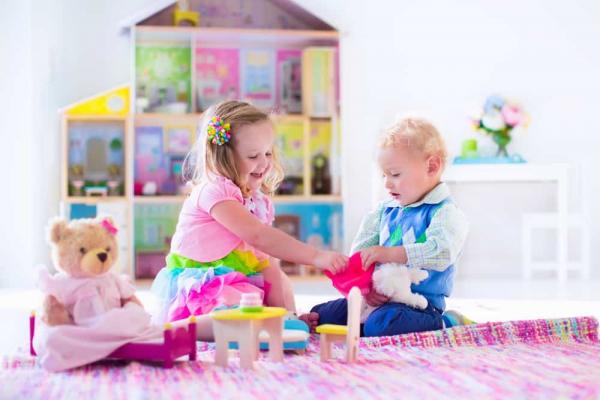
Science has officially found that boys want boy toys and girls want girl toys.
A new study done by researchers at City University London found that children who are as young as 9 months old prefer toys that are specific to their gender rather than toys targeted towards another gender.
The study, published in the journal Infant and Child Development, explained that this could be because male and female babies follow different developmental paths, and that there may be environmental reasons why babies prefer something tied to their gender.
"Biological differences give boys an aptitude for mental rotation and more interest and ability in spatial processing, while girls are more interested in looking at faces and better at fine motor skills and manipulating objects," Dr. Brenda Todd, a senior lecturer in psychology at City University, said in a statement. "When we studied toy preference in a familiar nursery setting with parents absent, the differences we saw were consistent with these aptitudes. Although there was variability between individual children, we found that, in general, boys played with male-typed toys more than female-typed toys and girls played with female-typed toys more than male-typed toys."
To find this, researchers had boys and girls play independently without their parents. Girls were offered dolls, pink teddy bears and cooking pots, whereas boys were given cars, blue teddy bears and a ball.
After breaking down the ages into three age groups - 9 to 17 months old, 18 to 23 months old and 24 to 32 months old - the researchers found that the boys and girls were both drawn to toys that were "stereotypical." As they got older, all groups tended to favor toys that would be considered stereotypical for boys, according to the study.
"Our results show that there are significant sex differences across all three age groups, with the finding that children in the youngest group, who were aged between 9-17 months when infants are able to crawl or walk and therefore make independent selections, being particularly interesting; the ball was a favorite choice for the youngest boys and the youngest girls favoured the cooking pot," Todd said.
This finding comes despite recent discussion about which toys boys and girls should be allowed to play with. As Todd explained in the study, there's been an uncertainty about whether boys and girls prefer toys tied to their own gender and how that affects a child's development. This piece of research shows that yes, indeed, children are drawn to toys that match their gender.
Previous research has linked these preferences to evolutionary reasons, according to LiveScience. Boys and girls tend to favor toys that match up with ancient gender roles - like, for example, boys preferring trucks and sports balls because they encourage more rigorous and physical activity, according to LiveScience.
But other research, like a 2009 study from Texas A&M University, found that children tend to embrace toys based on what they prefer and like, not what their bodies are asking for.
"It's hard to interpret what the looking data mean because we don't know why people are attracted to specific things," Kim Wallen, a psychologist at Emory University, said, according to LiveScience. "Clearly children recognize that certain objects in their environment are appropriate for certain activities. They could be looking at a certain toy because it facilitates an activity they like."
Researchers like Wallen argue that boys prefer trucks because of the way their minds work. Specifically, their minds rotate in a way that a girl's brain doesn't, which is why they prefer toys that rotate, like trucks or balls.
"Multiple studies in humans and primates shows there is a substantial male advantage in mental rotation, which is taking an object and rotating it in the mind," Wallen said. "It could be that manipulating objects like balls and wheels in space is one way this mental rotation gets more fully developed."
Of course, the reason why children stick with the toys that fit their gender may stem from societal beliefs. A 2013 study out of Plataforma SINC found that modern toy commercials market products to specific genders, with girl toys highlighting "beauty" and boys toys promoting "strength and power."
These researchers looked at close to 595 toy advertisements around Christmas time from 2009 to 2011 and found that the majority of them target specific genders, like with phrases such as "What is a woman? The engine driving a broom" when marketing girl toys.
The researchers found there's somewhat of a change underway in how toys are marketed towards gender, with the idea being that advertisers can do better to promote boy-centered toys among girls and vice versa.
For example, commercials that are often targeted towards girls now have boys in the background. Similarly, ads for crossbows, a toy normally reserved for boys, now show the piece of weaponry colored pink.
The researchers also specifically pointed to Goldieblox, a U.S. toy company that markets its female toys for "future engineers," as an example of a company looking to change how toys are promoted to both genders.
Still, Esther Martínez, researcher at Rey Juan Carlos University, said in the study that there's still work to be done to make sure boys and girls both feel like they can buy a toy even when it's marketed to another gender.
"Just because a boy is seen in a doll advert will not make the boys watching identify with it," she said.

